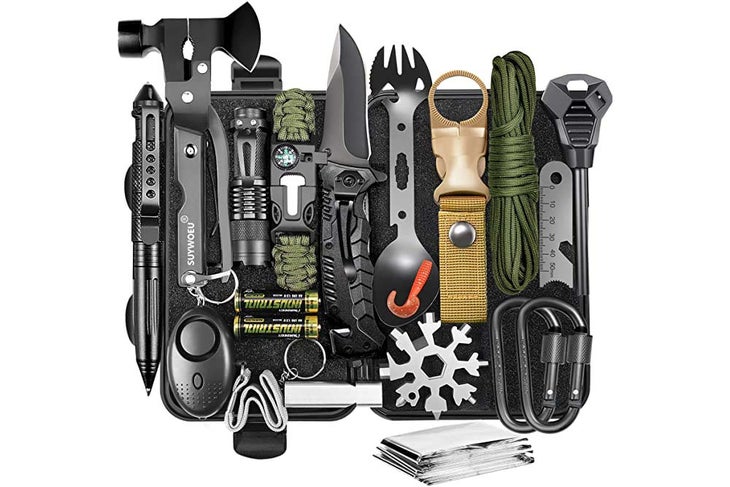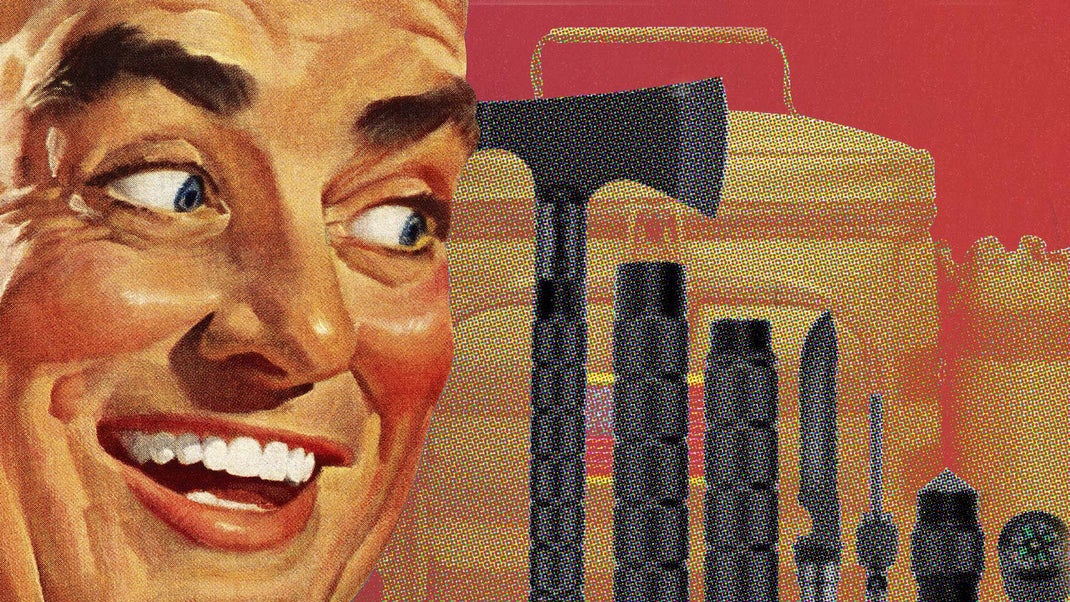No products in the cart.
Outdoor Adventure
The Toxic Masculinity of Tactical Survival Gear
Not an Outside+ member? Read a preview of this story and sign up today.
If, like me, you’re a man who enjoys hikes and you have access to the internet, a website has probably tried to sell you some kind of “survival tool” recently. Most likely, it was very sharp and had a compass and three fire-starting tools built into it. There’s a whole solar system of these products and a whole survivalist mode of masculinity that orbits around them: increasingly, it seems as though late-stage capitalism wants men like us to see ourselves as unable to trust anything but our own strength, pitting ourselves against nature and the remnants of society with nothing but our EDC tactical pocket tomahawks to help us survive.
If you’ve ever, you know, actually been outside, you don’t need me to tell you how off the mark this is. Marketers want us to believe we should be the Road Warrior when, by and large, we are people who like to go camping and sometimes click on targeted adverts on Twitter while we wait for our barista to make us a fancy coffee. We do not need more axesaws, or sawaxes, or tactical shovels with included ax and saw. The fact that there seems to be a whole subset of the outdoor industry dedicated to selling me items that are at once a terrible tool, a useless navigation aid, and an unconscious parody of masculinity is something that should really cause us to reflect on how our toxic ways of looking at gender can infect the way we relate to the outdoors.
Now, look: I’m a guy who likes doing “guy stuff.” I drink whiskey that comes in plastic bottles, and when I drink too much of it, I talk about my feelings, which I otherwise keep similarly bottled. I shave only when I have to go to meet a real adult, and sometimes I go into the desert in my pickup truck to shoot at paper bad guys with my friends. But even I think this man-versus-wild shtick is getting ridiculous.
Modern society breeds alienation, boredom, and despair like at no time in the past, and the unrealistic expectations that popular media heaps on men (well, OK, everybody) only makes that worse. There’s nothing wrong with being a suburban dad who goes camping on the weekend, but when targeted advertising tells you that you ought to be a Navy SEAL with an eight-pack, three different knives on your person, and the ability to start a fire with two rocks and a pile of wet moss, it sure can feel like it.

Lots of people want to escape the pressures of everyday life, and the outdoors is a wonderful place to disconnect, re-center, and remember what it is to be human. But hiking isn’t about conquering the outdoors, like some kind of C-tier Rambo with a fragile mail-order machete. It’s about learning to exist there with your friends, and the equipment we bring should reflect that. That doesn’t mean you should never carry survival tools, but most useful survival equipment is much less flashy than an axesaw. Bring a bivy bag and a first aid kit, get a Garmin InReach, and learn to navigate using a paper map and (real) compass. But if you’re out there just looking for a chance to sink your pocket chainsaw into a tree (which your grandchildren could appreciate if you just left it alone), you’re doing it wrong.
The thing about survival, and the outdoors, is that both are much better with other people. In crisis after crisis, be it flood or famine or getting stuck in the woods with a broken leg, the people who survive the best are those who cooperate the most, not the people with the biggest collection of mall-ninja axes and gas-station knives. Indigenous people thrived on this continent for millennia not in some kind of Hobbesian state of nature but as communities. Survival of the fittest might have brought us here over millions of years, but once we became us, it was cooperation between the fittest, smartest, and everyone else that allowed us to thrive.
In the past three centuries, however, we’ve managed to irredeemably destroy a huge chunk of the natural bounty that supported America’s inhabitants for the 24,000 years before that. If we want to keep our public lands intact in the face of climate change and land grabs, a tactical ax that was made in China and shipped halfway around the world just to shatter the first time someone tried to split firewood with it isn’t going to help us. What will help us is each other.
Most of our wildernesses belong to everyone these days. That doesn’t mean everyone is free to butcher them in whatever way they please without anyone else speaking up. On the contrary, it means we all must work out a way to use them, enjoy them, and, perhaps most important, preserve them. Saws, machetes, and axesaw machetes aren’t great at preserving things, but they are great for mangling and destroying them. That’s the exact combination of capitalism and colonialism that looked at a country already inhabited by Indigenous people, saw only an empty wilderness, and proceeded to pillage it clear to the edge of a climate crisis.
I’m not saying it’s ridiculous to be prepared for an unforgiving future. Fires in the Pacific Northwest and flooding on the East Coast this autumn have given us clear examples of just how climate change can impact the outdoors. We can learn a lot from backpacking that will help us, from filtering water to splinting limbs—outdoor skills are and always have been survival skills. But buying poor-quality combo tools and cheap faux-milspec gear isn’t what’s going to help there either. Survival, in the societal and individual sense, depends on cooperation. That means spending time with people, not money on things you can wrap with paracord.
Source link

